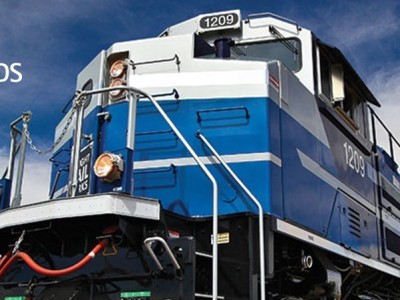FRA proposes to amend Safety Technology Regulations to establish strict safety standards while enabling railroad operations
Oct 25, 2024New proposed rulemaking seeks to ensure that railroad operations can continue safely under limited circumstances when positive train control systems are temporarily disabled
The U.S. Department of Transportation’s Federal Railroad Administration (FRA) today published a notice of proposed rulemaking (NPRM) proposing to amend certain regulations on positive train control (PTC) systems. PTC technology is designed to prevent train-to-train collisions, over-speed derailments, incursions into established work zones, and movements of trains through switches left in the wrong position. This NPRM seeks to improve the efficiency and safety of railroad operations by standardizing regulations concerning railroad operations when PTC systems are not enabled, which can occur due to a PTC outage or when PTC systems are temporarily disabled to facilitate maintenance, repairs, or upgrades to railroad infrastructure.
“This proposed rulemaking intends to establish clear, uniform processes for addressing issues with PTC systems while eliminating uncertainty and inconsistent application of FRA’s regulations,” said FRA Administrator Amit Bose. “We expect that these changes will ensure that railroads consistently provide FRA with the information necessary to assess the scope and circumstances of temporary outages in a timely manner, establish additional operating requirements to protect public and worker safety when outages occur, and enhance the efficiency of rail operations.”
Under the Rail Safety Improvement Act of 2008, Congress mandated the implementation of PTC systems on Class I railroad main lines that carry high levels of freight traffic and certain hazardous materials, on main lines over which intercity or commuter rail passenger transportation is regularly provided, and other tracks as prescribed by the Secretary. As of December 2020, PTC technology is in operation on all required freight and passenger railroad route miles, and PTC technology currently governs rail operations on nearly 59,000 route miles.
Under the Biden-Harris Administration, USDOT and FRA have taken unprecedented actions to improve rail safety.
Finalizing new safety regulations: USDOT has taken historic steps to improve the safety of railroads for workers and communities through rulemaking.
Train Crew Size Safety Requirements: FRA issued a long-awaited rule that ensures trains are safely staffed by establishing minimum safety requirements for the size of train crews. The new rule will enhance safety in the rail industry by generally requiring and emphasizing the importance and necessity of a second crewmember on all trains.
Certification of Signal and Dispatcher Employees: FRA issued final rules to require railroads to develop written programs for certifying dispatchers and signal employees.
Requiring Emergency Escape Breathing Apparatus: FRA issued a final rule requiring railroads to provide emergency escape breathing apparatus to train crews and other employees when transporting certain hazardous materials.
Advanced Notification for First Responders: The Pipeline and Hazardous Materials Safety Administration issued a final rule to require railroads to always maintain — and update in real-time — accurate, electronic information about rail hazmat shipments in a train consist that would be accessible to authorized emergency response personnel.
Utilizing safety oversight authorities: FRA is consistently drawing attention to emerging rail safety concerns with more than 20 Safety Advisories and Bulletins combined over the last three years; holding railroads accountable through enforcement action; assessing one of the highest amounts ever in the agency’s records for Class I freight railroads in 2023; and undertaking new, focused efforts to ensure safety, such as conducting safety audits and examining the nation’s high-hazard flammable train routes following the 2023 Norfolk Southern derailment in East Palestine, Ohio.
Expanding vital safety to include workers at Class I freight railroads: At Secretary Buttigieg’s urging, a growing number of workers employed at the Class I freight railroads can finally report their experiences to FRA’s Confidential Close Call Reporting System (C3RS) — a vital safety program that allows workers to confidentially report unsafe events and share valuable insight to prevent future incidents.
Deploying historic infrastructure investments: USDOT continues to deploy the historic resources from President Biden’s Bipartisan Infrastructure Law to upgrade rail infrastructure and improve the safety of communities across the country, notably through FRA’s Consolidated Rail Infrastructure and Safety Improvements (CRISI) Program and Railroad Crossing Elimination Program.
Similar Stories

AAR reports rail traffic for the week ending November 23, 2024
View ArticleA. Stucki Company completes sale of Velocity Rail Solutions and embarks on new chapter of growth
A. Stucki Company (“Stucki”), a leading supplier of highly engineered parts and services for the rail industry, and a portfolio company of Stellex Capital Management (“Stellex”), announced today it has…
View ArticleExpanded rail yard enhances efficiency, decreases delays
The expanded central rail yard at The Port of Virginia has created an increase in efficiency with the port now able to process 2 million twenty-foot equivalent units (TEUs) by…
View Article
AtkinsRéalis provides US Federal Railroad Administration oversight and monitoring services
View Article
AAR reports rail traffic for the week ending November 16, 2024
View Article
New location, expanded capacity for MARS Winter Meeting, January 14–16, 2025
View ArticleGet the most up-to-date trending news!
SubscribeIndustry updates and weekly newsletter direct to your inbox!





